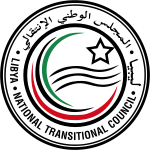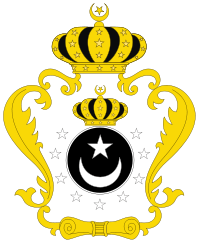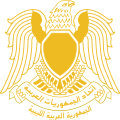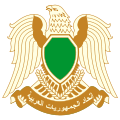- Coat of arms of Libya
-
After the collapse of the Gaddafi regime in the 2011 Libyan civil war, Libya currently does not have an official coat of arms. The National Transitional Council uses a seal or logo to represent itself, but while its Constitutional Declaration of August 2011 defines the flag of Libya, it does not make any provisions for a coat of arms.
Contents
Seal of the National Transitional Council
The National Transitional Council, supported as the legitimate administration by the United Nations since September 2011,[1] uses a seal to certify official documents. The emblem depicts a crescent moon and star, represented in the colours of the Libyan flag used by the NTC (red, black, and green), with the names of the council المجلس الوطني الانتقالي (al-majlis al-waṭanī al-intiqālī, "The Transitional National Council") and of the state ليبيا (Lībiyā, Libya) displayed in Arabic and English. [2]
History
Kingdom of Libya (1951–1969)
The emblem of the Kingdom of Libya, known as the "Crown of Libya", was used from 1952-1969.
The constitution of the Kingdom of Libya of 1952 in article 7 describes the flag, but not the emblem. No official description is available at present (due to the restrictions placed on government archives since the military coup of 1969), and the design is reconstructed from many variants in shape and color schemes. The design as represented in official government sources of 1952-1969, which describes the emblem, is as follows:
- Upper crown adorned with a white Crescent and five-pointed star at its summit, at which five visible side frames originating from a ring at the base converge. The star studded base and frame contain a velvet black head cover like object.
- The Upper crown is supported at its base by two ornate plantar designs; in the form of three intertwined C and S scroll shapes.
- Two massive “Shoulder” frames contain the body of the crown from the right and left [...]. Each side is a complex formation of intertwined branches in the shape of an S Curve, which is essentially two back-to-back C scrolls; the larger one of which terminates in a large beautiful spiral at the top. [...]
- The background color of the large interior below the upper crown can be white or transparent, although this is not evident in the picture of the Libyan pound. The background color of the center region surrounding the large white crescent and star is black as in the center stripe of the Libyan flag.
- A white ring with thin black borders, surrounds the center large white crescent and star.
- Nine five-pointed white stars surround the center ring.
- Large white crescent.
- Five pointed star located well above the perimeter of the crescent. This differs from the flag, which places the star at the extremities of the crescent.
- A lower crown, seated above the ring containing the central crescent and star. Its design is identical to the upper crown, except for being smaller in size.
- Plantar/ floral ornamentation similar to #2 above, providing variation and connectivity to the base.
- At the base, an ornate design that resembles a document scroll with a ring tie at its center. It is noted that the color scheme of the crown is most likely white for the stars and crescents, black and white (or transparent) for spaces, and gold for the crowns and frames. [...]
The upward-pointing white crescent and star on black background is taken from the traditional banner of the Senussi dynasty.
Libya under Gaddafi
In 1970, Libya adopted a coat of arms similar to that of Egypt (the "Eagle of Saladin"), while in 1972 the Federation of Arab Republics unification plan led Libya to adopt a coat of arms similar to that of Syria (the Hawk of Quraish, or emblem of the tribe of the prophet Muhammad). On Libya's exit from the Federation in 1977 (to become the "Great Socialist People's Libyan Arab Jamahiriya"), the coat of arms of the Federation was changed to reflect the new green flag of Libya also adopted at that time, while the hawk was changed to face in the other direction. The phrase اتحاد الجمهوريات العربية (ittiħād al-jumhūriyyāt al-`arabiyya "Federation (literally Union) of Arab Republics") still remained written on the banner clutched in the feet of the hawk.
-
Libyan Arab Republic within the Federation of Arab Republics (1972-1977)
See also
- Flag of Libya
- National Anthem of Libya
- Coat of arms of Syria (the source of the hawk or falcon of Qureish)
References
Coats of arms and emblems of Africa Sovereign
states- Algeria
- Angola
- Benin
- Botswana
- Burkina Faso
- Burundi
- Cameroon
- Cape Verde
- Central African Republic
- Chad
- Comoros
- Democratic Republic of the Congo
- Republic of the Congo
- Côte d'Ivoire (Ivory Coast)
- Djibouti
- Egypt
- Equatorial Guinea
- Eritrea
- Ethiopia
- Gabon
- The Gambia
- Ghana
- Guinea
- Guinea-Bissau
- Kenya
- Lesotho
- Liberia
- Libya
- Madagascar
- Malawi
- Mali
- Mauritania
- Mauritius
- Morocco
- Mozambique
- Namibia
- Niger
- Nigeria
- Rwanda
- São Tomé and Príncipe
- Senegal
- Seychelles
- Sierra Leone
- Somalia
- South Africa
- South Sudan
- Sudan
- Swaziland
- Tanzania
- Togo
- Tunisia
- Uganda
- Zambia
- Zimbabwe
States with limited
recognition- Sahrawi Arab Democratic Republic
- Somaliland
Dependencies and
other territories- Canary Islands / Ceuta / Melilla / Plazas de soberanía (Spain)
- Madeira (Portugal)
- Mayotte / Réunion (France)
- Saint Helena / Ascension Island / Tristan da Cunha (United Kingdom)
- Western Sahara
Categories:- National symbols of Libya
- National coats of arms
Wikimedia Foundation. 2010.





